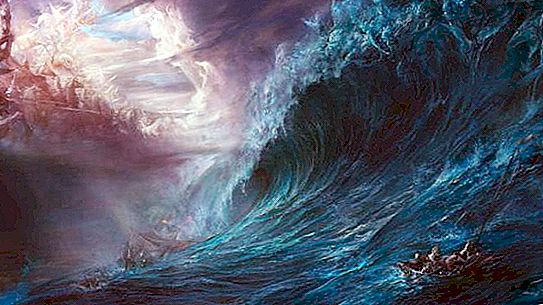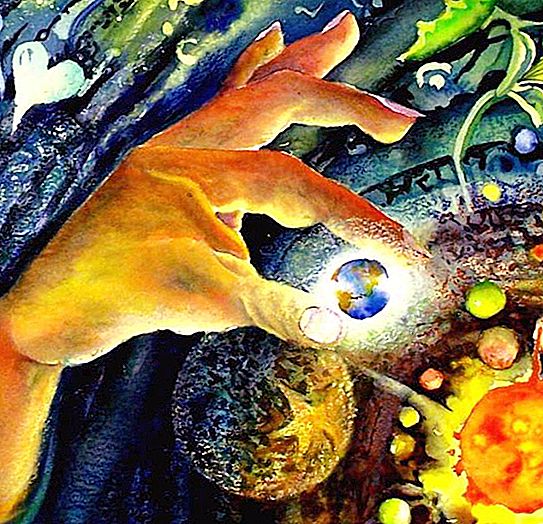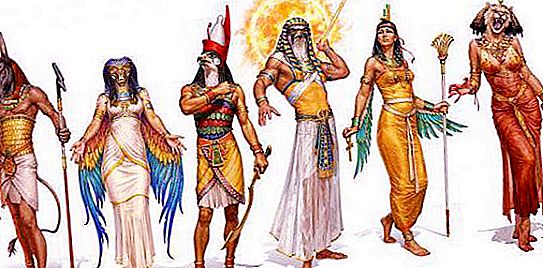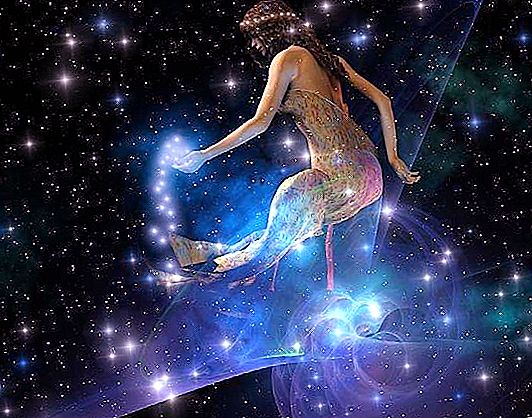Mythology is a very interesting culturological phenomenon. The significance of myths in modern culture can hardly be overestimated, because on their basis works of art and literature arose, and philosophical teachings were based. The uniqueness of this phenomenon lies in the fact that it has passed through millennia, preserved in the memory of generations. Consider the definition of myth, analyze their types in detail, and also clarify how the myth differs from fairy tales and legends.
Myth: definition, properties, occurrence
Our distant ancestors tried to explain all kinds of natural phenomena, their place in the world, the emergence of the Universe and its possible demise. After all, they did not have scientific knowledge, they did not know physics, astronomy or anthropology. And so the creation of myths took place. Gradually, with the development of science, interest in myths waned, but they were passed from mouth to mouth and thus reached modern times. This phenomenon is a true chronicle of human knowledge and ideas.

It is a mistake to believe that myth-making is the prerogative of ancient people. This is not so: in modern times we encounter this phenomenon. There is still something surreal, fantastic in human life. This is due to modern myths.
In the question of how the myth differs from the fairy tale, one should be guided by the functions of these phenomena. The tale is designed to teach, educate, maybe even entertain. A myth is another thing, which aims to explain the essence of things. Closest to him, researchers put magical tales, where natural elements help the heroes.
Even more polar concepts are myths and legends. The latter is a reflection of a certain historical event, which is always perceived as real-life. Myths and legends, and fairy tales were created by the people.
Cosmogonic Myths
The content of such stories is diverse, because they affect all aspects of human life. Therefore, the main types of myths are distinguished depending on what they are talking about. In addition, there are those that were created before the start of all knowledge in a pre-class society, but there are those that are reflected in the culture of civilization.
Cosmogonic is the first myth of any system. It talks about how the world was created. Typically, creation is preceded by chaos (ancient Greece), fragmentation, lack of order (ancient Egypt), the power of fire and water (mythology of the Scandinavians) or earth and sky in the world egg (mythology of ancient India).
All cosmogonic myths of the world are united by one plot: the creation of a world order system around a certain axis. It can be a tree - a world ash tree, like the ancient Scandinavians, or a luminary for controlling night and day in the Jewish tradition. Also, "order out of chaos" can create a marriage. So, in the mythology of ancient Greece, it is Uranus and Gaia, and in Polynesia - Pope and Ranks. It is noteworthy that the impetus to all this action gives the supreme deity: Vishnu, God.

Further, these types of myths describe the creation of the first people and the departure from the affairs of the supreme deity with the transfer of ownership of the creation into the hands of creatures.
Anthropogonic myths
Anthropological myths are closely related to cosmogonic ones. Some scientists do not separate them into a separate group, but consider them to be an integral part of the legends about the origin of the Universe. They tell about the origin of a person or a married couple. The appearance of the first people may be different. Summarizing the myths of the world, we come to the conclusion that a person happens in the following ways:
- Of totem animals, the most ancient mythologies, for example, Australian, teach this.
- From wood and clay (the first appears in Old Norse mythology, the second - among the Egyptians, Akkadians, Ob Ugrians).

- By moving from the lower world to the earth (among the Sumerians, the peoples of Tropical Africa).
- Revitalizing people, endowing them with a soul (this is usually the prerogative of mythologies, where there are two opposing deities, one, the “evil”, made unable to create a real person, and only the supreme deity gives soul and life). As an example, Christian mythology and Ob-Ugric can be cited.
Astral, solar and lunar myths
Types of myths telling about the origin of stars and planets - astral are close to cosmogonic. It is on them that astrology is based, which still exists. From the point of view of the ancient constellations, these are transformed animals, plants and even people (for example, a hunter). An interesting interpretation of the Milky Way in various mythologies. Most often it is a connection between worlds. The ancient Greeks associated him with Hera's milk, the Babylonians imagined him with the ropes holding the Earth in the Universe.
It was common for our distant ancestors to identify certain deities or animals with planets and stars, they observed their movement in the night sky, and revealed patterns. Such they appear in the mythologies of China, the Middle East. It is these beliefs that gave rise to the development of astrology.
A special place is occupied by ancient myths about the sun. They are in almost all mythologies. In some, these are heroes who somehow fell into heaven, sometimes for misconduct (Scandinavia), in others they are a couple of spouses or a brother and sister, where one (the moon) obeys another (the sun). For example, this is characteristic of the mythology of Korea.
Many nations identified their rulers with the children of the sun. These were the myths of the peoples of Egypt, Japan, South America (Inca tribe).
Etiological myths
Myths explaining the occurrence of plants, animals, weather phenomena, landscape features are called etiological. These are very ancient myths dating back to primitive society. Of course, the ability to discover the cause of things unites mythological beliefs in general, however, it is the etiological ones that aim to tell about the origin of everything that surrounds a person.
At the very first stage are myths that we now perceive as the tales of the peoples of Australia, New Guinea, the Adaman Islands. For example, they explain the daytime blindness of bats, the absence of a tail in a marsupial bear.
A notch is a belief that explains the appearance of plants and animals in principle. These are myths about the origin of dolphins from malicious shipbuilders, and the weaver Arachne, punished by Aphrodite, is the spider.
The most perfect etiological beliefs tell of the appearance of the stars: the sun, moon, firmament. Such myths exist in every religion. For example, in New Zealand and Egypt, the appearance of the sky is explained by a higher power that “torn” the sky from the earth. Also, the myths of peoples, absolutely everyone, explain the daily and annual movement of the sun in the sky.
A subcategory of etiological myths is cult: they tell how a particular rite occurred, why it must be performed in this way, and not otherwise.
Heroic myths
Heroes of myths of this subject are the center of the story. It tells about life, any feats, performing overwhelming tasks. The structure is approximately the same:
- The wonderful birth of a hero.
- The feats or trials imposed by the father or some other close relative can also be initiated by the future father-in-law, the leader of the tribe, and even the deity. As a rule, at this stage the hero is an exile: he violated the social taboo, committed a crime.
- Meeting with the future wife and marriage.
- Continuation of feats.
- The death of a hero.
If we talk about the mythology of the ancient Greeks, then the heroes of myths are the children of God and a mortal woman. It is these beliefs that underlie fairy tales and other epic works.
Myths totemic and cult
The following types of myths are quite similar in theme: totemic and cult. A classic example of the former is the deities of Ancient Egypt, each of which had certain zoomorphic features: crocodile, cat, jackal and others. These myths reflect the kinship of certain groups, castes of people and totems, which are animals or plants.

In addition to the Egyptian deities, the mythology of the Australian tribes can be cited as an example, where sacred stones, animals, plants are reincarnated once zoomorphic ancestors who lived. The same beliefs were among the Papuans and Bushmen.
Quite often in totemic myths the theme of the marriage of a zoomorphic creature and an ordinary person is encountered. As a rule, this explains the origin of nationalities. The Kyrgyz, Orocs, Koreans have it. Hence the images of fairy tales about the frog princess or Finist Yasniy Sokol.
Cult myths are perhaps the most mysterious. Their content is known to a few, mainly guardians of the cult. They are very sacred and tell about the root cause of any action. A classic example is bacchanalia, organized in honor of the ancient Greek god Dionysus. Another example is from Ancient Egypt. Myths about the gods Osiris and Isis were the basis of the cult action, when Isis sought the body of her lover, after which he resurrected.
Eschatological myths
Eschatological legends telling about the end of the world logically complete the majority of beliefs. These types of myths are antonymic to the cosmogonic. Only the world here is not being created, but is being destroyed. As a rule, the impetus is the impoverishment of the moral principles of society. Such beliefs are characteristic for highly developed mythologies. For example, the ancient Scandinavians, Indians, Christians.

The topic of eschatological beliefs can be divided into several groups:
- A global catastrophe is described, which separated the world of myth from the present. These are the representations of Kets and Sami.
- The loss of the "golden age" of mankind, its imperfection. An example is Iranian mythology, which describes three cosmic eras, each with a moral quality worse than the previous one. This also includes Ragnarok from the mythology of the Scandinavians - the universal fire, which will have to renew the planet.
- Another topic is the cyclical nature of civilizations, where at the end of each period a catastrophe occurs, as if cleansing the Earth. This, for example, the era of the four suns in the mythology of the Aztecs. The first ends with an attack of the jaguars, the second with hurricanes, the third with a fire, and the fourth with a flood.
- Messianism. It is a mistake to believe that this is the prerogative of Christian beliefs. Myths about Messiah gods are in Hinduism (Kalki), and Islam (Mahdi), and Buddhism (Maitreya Buddha).
Calendar myths
Calendar types of myths are closely related to cosmogonic and cult ones. It was common for mankind to explain the change of seasons, day and night, the dying of nature in autumn and winter, and the resurrection in spring.

These thoughts are reflected in the myths of the calendar. They are based on observations of astronomical phenomena, festivities on the occasion of the entry into the new calendar year, harvesting and planting crops. Consider the most interesting mythologies from the perspective of this topic.
If we talk about the change of months in a year, there is a close connection with astral myths. The alternating months are explained in terms of zodiac signs. Mesopotamian mythology succeeded especially in this.
In the beliefs of the ancient Egyptians, the god Thoth was responsible for the time, his shift and movement of the stars in astrology and astronomy. Thanks to him, the year is divided into 365 days. The last 5 were allocated so that the deities Osiris, Seth, Isis and others were born. The five-day celebrations at the end of the calendar year were dedicated to them. If we talk about the change of day and night - the Egyptians explained it this way: the god Ra descends in a boat to the underworld or Seth and Horus fight.
In ancient Rome, each calendar month was attributed to a certain deity: April - Aphrodite, June - Juno, March - Mars. The beginning of each month was determined by the priest by the new moon. In adjacent to Roman Greek mythology there were deities - mountains responsible for changing the seasons.
God Marduk from the mythology of the Sumerians and Akkadians was responsible for the calendar. A new year for these peoples began on the vernal equinox.
The change of seasons in some mythologies is associated with the life and death of a deity. It is enough to recall the ancient Greek story of Demeter and Persephone. Hades stole the last into his underworld. Demeter, being the goddess of fertility, missed her daughter so much that she deprived the land of fertility. Although Zeus ordered Hades to return to Persephone, she was forced once a year to return to the kingdom of the dead. With this, the Greeks associated the change of seasons. Similar stories with mythical heroes Osiris, Yarila, Adonis, Baldr.




